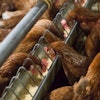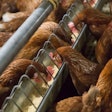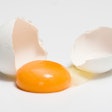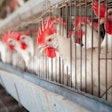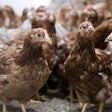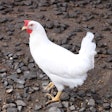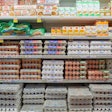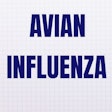In a new study by Jones and Musgrove, 2005 (Journal of Food Protection 68:2035-2038) further data were reported on the effect of egg shell strength on penetration of Salmonella enteritidis (SE) into the egg contents. Since it is well-known that shell quality can be influenced through genetic selection, their goal was to consider eggshell strength as a selection factor against SE penetration if a significant correlation exists.
Visibly clean eggs were collected and placed in a 42°C (107°F) incubator for 20 to 22 hours prior to inoculation. The eggs were candled to assure structural integrity. Thirty pre-warmed eggs were inoculated by dipping them into a suspension of nalidixic acid-resistant SE at 106CFU/ml at 4-5°C. Control eggs were dipped in sterile buffered peptone water. All eggs were stored at room temperature.
Results indicated no difference in shell strength of the control and inoculated eggs. In another phase of the study the replicates were separated which showed some significant differences in shell strength between the three replicates. No differences, however, were observed between treatments with respect to the relationship of shell strength to SE contamination in the egg contents.
Since the first study indicated a low number of positive eggs, a second study was designed to include SE enrichment. They observed similar shell strength and SE counts on the shell surface and contents. After enrichment, 100% of eggshell surface samples were positive for SE. When enriched, 5.2, 3.5 and 5.2% of the egg contents from replicates 1, 2 and 3, respectively, were observed to be positive for SE. However, no significant correlation was found between shell strength and SE contamination in the egg contents.
The authors indicated that eggs used in this study were not washed prior to inoculation which may have influenced the SE migration into the egg contents. All eggs in the United States are washed and sanitized. This washing process is known to at least remove part of the cuticle. A future study should use washed eggs. These researchers also felt that a future study should include a wider range of shell strength. Shell strength values ranged from 3,600 to 3,900g in this study.
There are several factors that affect penetration of bacteria into the shell contents. The shell porosity and shell membrane thickness have also been observed to influence the penetration of SE into the egg contents. Research has shown that it takes from approximately 7 to 15 days for Salmonella to penetrate into the egg contents at room temperature. Since eggs in market channels in the United States are required to be held at 7.2°C, this would likely delay penetration of SE. Most of the SE contamination is recognized to come through the shell. Therefore, more research emphasis on improving shell strength as well as other shell quality factors and its influence on SE penetration into the egg contents is needed in future studies. (Dr. Glenn W. Froning, Professor Emeritus, Department of Food Science and Technology, University of Nebraska, Lincoln, NE 68583-0919)
